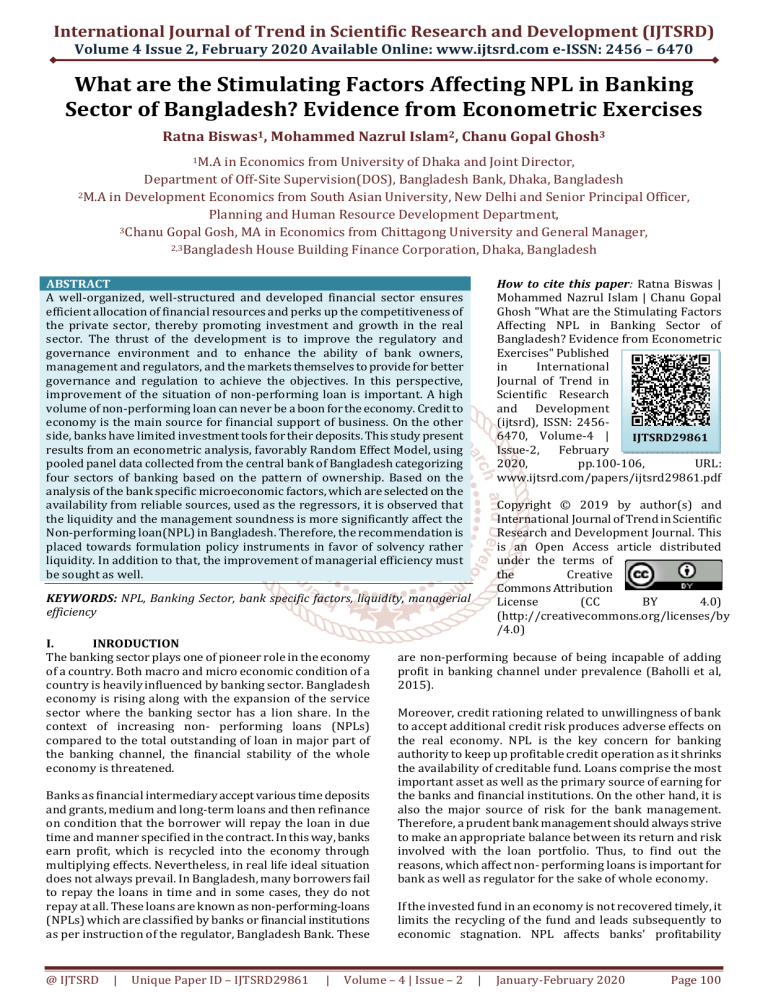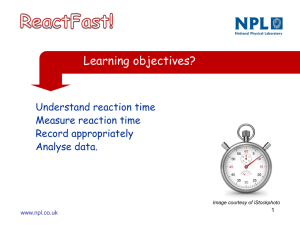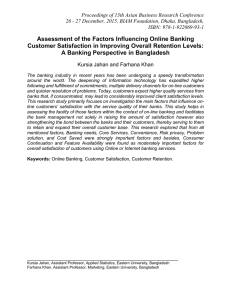
International Journal of Trend in Scientific Research and Development (IJTSRD)
Volume 4 Issue 2, February 2020 Available Online: www.ijtsrd.com e-ISSN: 2456 – 6470
What are the Stimulating Factors Affecting NPL in Banking
Sector of Bangladesh? Evidence from Econometric Exercises
Ratna Biswas1, Mohammed Nazrul Islam2, Chanu Gopal Ghosh3
1M.A
in Economics from University of Dhaka and Joint Director,
Department of Off-Site Supervision(DOS), Bangladesh Bank, Dhaka, Bangladesh
2M.A in Development Economics from South Asian University, New Delhi and Senior Principal Officer,
Planning and Human Resource Development Department,
3Chanu Gopal Gosh, MA in Economics from Chittagong University and General Manager,
2,3Bangladesh House Building Finance Corporation, Dhaka, Bangladesh
How to cite this paper: Ratna Biswas |
Mohammed Nazrul Islam | Chanu Gopal
Ghosh "What are the Stimulating Factors
Affecting NPL in Banking Sector of
Bangladesh? Evidence from Econometric
Exercises" Published
in
International
Journal of Trend in
Scientific Research
and Development
(ijtsrd), ISSN: 24566470, Volume-4 |
IJTSRD29861
Issue-2, February
2020,
pp.100-106,
URL:
www.ijtsrd.com/papers/ijtsrd29861.pdf
ABSTRACT
A well-organized, well-structured and developed financial sector ensures
efficient allocation of financial resources and perks up the competitiveness of
the private sector, thereby promoting investment and growth in the real
sector. The thrust of the development is to improve the regulatory and
governance environment and to enhance the ability of bank owners,
management and regulators, and the markets themselves to provide for better
governance and regulation to achieve the objectives. In this perspective,
improvement of the situation of non-performing loan is important. A high
volume of non-performing loan can never be a boon for the economy. Credit to
economy is the main source for financial support of business. On the other
side, banks have limited investment tools for their deposits. This study present
results from an econometric analysis, favorably Random Effect Model, using
pooled panel data collected from the central bank of Bangladesh categorizing
four sectors of banking based on the pattern of ownership. Based on the
analysis of the bank specific microeconomic factors, which are selected on the
availability from reliable sources, used as the regressors, it is observed that
the liquidity and the management soundness is more significantly affect the
Non-performing loan(NPL) in Bangladesh. Therefore, the recommendation is
placed towards formulation policy instruments in favor of solvency rather
liquidity. In addition to that, the improvement of managerial efficiency must
be sought as well.
Copyright © 2019 by author(s) and
International Journal of Trend in Scientific
Research and Development Journal. This
is an Open Access article distributed
under the terms of
the
Creative
Commons Attribution
License
(CC
BY
4.0)
(http://creativecommons.org/licenses/by
/4.0)
KEYWORDS: NPL, Banking Sector, bank specific factors, liquidity, managerial
efficiency
I.
INRODUCTION
The banking sector plays one of pioneer role in the economy
of a country. Both macro and micro economic condition of a
country is heavily influenced by banking sector. Bangladesh
economy is rising along with the expansion of the service
sector where the banking sector has a lion share. In the
context of increasing non- performing loans (NPLs)
compared to the total outstanding of loan in major part of
the banking channel, the financial stability of the whole
economy is threatened.
Banks as financial intermediary accept various time deposits
and grants, medium and long-term loans and then refinance
on condition that the borrower will repay the loan in due
time and manner specified in the contract. In this way, banks
earn profit, which is recycled into the economy through
multiplying effects. Nevertheless, in real life ideal situation
does not always prevail. In Bangladesh, many borrowers fail
to repay the loans in time and in some cases, they do not
repay at all. These loans are known as non-performing-loans
(NPLs) which are classified by banks or financial institutions
as per instruction of the regulator, Bangladesh Bank. These
@ IJTSRD
|
Unique Paper ID – IJTSRD29861
|
are non-performing because of being incapable of adding
profit in banking channel under prevalence (Baholli et al,
2015).
Moreover, credit rationing related to unwillingness of bank
to accept additional credit risk produces adverse effects on
the real economy. NPL is the key concern for banking
authority to keep up profitable credit operation as it shrinks
the availability of creditable fund. Loans comprise the most
important asset as well as the primary source of earning for
the banks and financial institutions. On the other hand, it is
also the major source of risk for the bank management.
Therefore, a prudent bank management should always strive
to make an appropriate balance between its return and risk
involved with the loan portfolio. Thus, to find out the
reasons, which affect non- performing loans is important for
bank as well as regulator for the sake of whole economy.
If the invested fund in an economy is not recovered timely, it
limits the recycling of the fund and leads subsequently to
economic stagnation. NPL affects banks' profitability
Volume – 4 | Issue – 2
|
January-February 2020
Page 100
International Journal of Trend in Scientific Research and Development (IJTSRD) @ www.ijtsrd.com eISSN: 2456-6470
adversely because of keeping the provision of classified
loans and consequent write-off as bad debts, reduces return
on investment (ROI), and disturbs the capital adequacy ratio
(CAR). It also increases the cost of capital, widens assets and
liability imbalance and upsets the economic value additions
(EVA) by banks.
In Bangladesh perspective, before privatization and
liberalization, banking activities were directed to disburse
credit, according to the government’s economic priority, and
hence, little attention was placed to identify the problem
loans and making provisions thereon, although there was
significant amount of hidden default loans. After 1982, the
banking sector of Bangladesh underwent a rapid
denationalization and privatization process. Henceforward,
private banks were allowed to conduct banking operations
in order to increase competition, reasons, the efficiency and
productivity of the banking sector (Alexandin and Santoso,
2015).
But due to the various reasons in reality, the efficiency of the banking sector was not improved rather the credit discipline was
further eroded. The very frequent and fashionable style of loan defaulting story in banking sector of Bangladesh is loan scam.
Recently, a series of scams has started threatening the banking sector in a great way. Sonali Bank loan scam started the episode
and is continuing with Bismillah, Basic Bank loan scam and so on in a large scale1. The story of all episodes is almost same and
follows a cycle. The short snap of NPL of various banks in middle quarters of fiscal year 2014-2015 was provided in the
following chart.
Figure1.1: Amount of defaulted loan in Bangladesh Banking sector from specified period in FY 2014-2015.
Source: Banking Regulation and Policy Department, Bangladesh Bank.
II.
Background of the study:
The NPL always raises concerns among policy makers. Therefore, the central bank takes various measures to control the
increasing volume of classified loans. Bangladesh Bank has also adopted various policies, such as, loan re-scheduling facility,
introduction of CIB report, waiver of interest, write off bad loans etc. to check this excessive volume of NPL. But all these
initiatives have not still been successful in producing the desired outcome. Although rescheduling reduces the amount of NPL, it
cannot be an end in itself. Loan is rescheduled after the damage is already done. Moreover, statistics indicates that only a
handful of lucky borrowers get this opportunity. These elite capturing is aggravating the status of NPL in banks and financial
institutions. The real solution to this problem can be worked out when the reasons of NPL are known accurately and policies
are put in place to prevent a loan from becoming an NPL. Hence, the different dimensions of NPL in Bangladesh deserve an
independent analysis from both an academic point of view and a policy perspective. Against this backdrop, this study is an
attempt to identify the factors that affect non-performing loan at the different categories banks and financial institutions of
Bangladesh specifically the type and period wise NPL.
III.
Methodology and Analysis:
Data collection, cross sections and time preference: For this study, the data are collected mainly from consolidated annual
data from central Bank of Bangladesh, Bangladesh Bank quarterly, monthly economic trend and other secondary data sources
available in Bangladesh Bank with the preference of time interval from 2005 to 2016 on yearly basis. In those data, the banking
sectors are categorized in their kinds of ownership into four types - state-owned commercial banks (SCBs), state-owned
development financial institutions (DFIs), private commercial banks (PCBs) and foreign commercial banks (FCBs), which are
here taken as the no of cross sections. As the banks-wise data for the desired variables are not published in Bangladesh bank
and not availed in other reliable sources as well in the time of study, the sector-wise data are used for data authenticity.
11Sonali Bank Ltd is the largest a state-owned commercial bank and basic bank is a specialized state owned commercial bank
and Bismillah is a private commercial company are found indulged in separate credit scam which has raised public outcry over
the country in recent years.
@ IJTSRD
|
Unique Paper ID – IJTSRD29861
|
Volume – 4 | Issue – 2
|
January-February 2020
Page 101
International Journal of Trend in Scientific Research and Development (IJTSRD) @ www.ijtsrd.com eISSN: 2456-6470
Selection and description of variables: Literature surveyed for the study shows that the NPL is varying on many factors;
primarily two types of factors; bank specific factors (microeconomic) and macroeconomic factors (Curak et al ,2013). The
macroeconomic factors such as GDP, inflation, interest rate, real exchange rate, claim to be included in the analysis to trace the
stimulating factors of NPL. But the direction of effect of those variables in NPL are not found deciding in literature (Baholli and
others, 2015; Alexandin and Santoso, 2015). The influences are multiplied and adjusted with counter and anti-counter actions
on NPL. This multiplicity and versatility of the effect of macro-variables is complicated and beyond of scope of the study.
Therefore, this study has intended to focus only on some quantifiable Bank specific factors, taken as explanatory variables, such
as capital adequacy (CAR), bank size (ASSET), liquidity ratio (LR), Profit to manpower ratio (PM) and expenditure to income
ratio (EI) whereas NPL is taken as the dependent variable (regressand). Here, data of 56 banks divided into four sectors (SCB,
DFI, PCB and FCB) and the 15 times periods (2005-2016) of balanced panel data in 48 observations.
Estimation of Model and Empirical Analysis: For analysis of this panel data, three major types of econometric technique are
found in conventional literature provided as follows-
Pooled OLS method (POLS)
Technique used in analysis
Fixed Effect Method (FEM)
Random Effect Method (RAM)
Among the three techniques mentioned above, the REM is used as favored model in this study which is described in the
following with variables employed in.
i = 1,2,3,4…...; t = 1,2,3………….,15 years.
Here, β1i is not fixed rather is assumed to be random variable with mean value of β1 where
β1i = β1 +εi……………… (ii)
β1i = Intercept value for individual bank. εi = Random error term with (0, ơ2).
The desired equation of the model is found by substituting (ii) into (i)
β1
2
where
=
.
At first, the Pooled Ordinary Least Square (POLS) method is used to regress the variables. After Pooled OLS, it is found that the
variable CAR, Size, LR, PM are statistically significant. Only EI has shown the statistically insignificant value. Even R2- value is
less than the Durbin-Watson statistics.
However, the problem here, the banking sectors individually are not distinguished. It is assumed that all the banking sectors
are same in case of Pooled OLS method, there is a possibility of having the correlation between the error term and the some of
the regressors in the model. Hence, it is needed the test to accept or reject the null hypothesis; the differential intercepts are
equal to zero. It is seen that the differences are in banking sector is not equal to zero. Therefore, given the circumstances, the
Pooled OLS cannot be considered as desirable technique.
In case of Fixed effect method (FEM), it has been found that the statistically significant variables are only two. These are LR and
EI. Interestingly, the results obtained from the Random effect method (RAM) has shown the same manner as the Fixed effect
method. The variables LR and EI are the only significant in RAM too. Even, the trend, the sign of variables is same in both cases.
To accept the result between FEM (Fixed effect model) and REM (Random effect model) the Hausman Test has been carried
out. In case of Hausman test, the null hypothesis was ‘FEM & REM estimators do not differ substantially’.
2
= Cross- section random error, = Idiosyncratic random error, NPL= Non Performing Loan, CAR= Capital adequacy ratio,
Asset= Size of the bank on asset basis, LR= Liquidity, PM= Profit to Manpower Ratio, EI = Expenditure to Income ratio.
@ IJTSRD
|
Unique Paper ID – IJTSRD29861
|
Volume – 4 | Issue – 2
|
January-February 2020
Page 102
International Journal of Trend in Scientific Research and Development (IJTSRD) @ www.ijtsrd.com eISSN: 2456-6470
Figure3.1: The result of Hausman test showing the differences between the values of coefficients is insignificant.
Since the estimated Chi-square value is not statistically significant, the null hypothesis has been accepted that there is no
significant difference in the estimated co-efficient of the two models. It seems, there is no substantial correlation between the
error term and one or more regressors. Hence, we can accept the random effects model in disfavor of the fixed effect model. It is
also noted that in the last part of table of the Hausman test the value of any coefficient isn’t significantly different in the two
models.
IV.
Explanation of the result:
Now, it is needed to discuss the behavior of variables in the REM model. At first, the less value of R2 than that of DW removes
the possibility of spurious regression. Therefore, the result found from this regression analysis is consistent.
Figure4.1: The sign and value of coefficients affecting NPL are found from three types of equation in panel data
analysis
Among the five explanatory variables, LR and EI has been found influencing the NPL significantly. The influences of other three
variables are not significant in this analysis. It has been come out that the LR is positively related to the NPL. It is quite similar
to many studies in the literature (Vantansever & Stepsen, 2013; Curak et al 2013). The implication is that the more liquidity of
bank, the more tendency to disbursing credit (Investopedia, 2017). Banks feel pressure to accept more credit proposals in case
of excess liquidity. As a result, the selection of right borrower is not always ensured. The scope of adverse selection is increased
in the way of desperate investing mode of banking arisen from the extra liquidity.
Figure4.2: The sign and the value of the stimulating (explanatory) variables affecting NPL, the dependent variable
with probability of significance
@ IJTSRD
|
Unique Paper ID – IJTSRD29861
|
Volume – 4 | Issue – 2
|
January-February 2020
Page 103
International Journal of Trend in Scientific Research and Development (IJTSRD) @ www.ijtsrd.com eISSN: 2456-6470
The second significant variable is the EI. It is very interesting and intuitive in this analysis. EI is taken as one indicator of
management soundness. As much as the expenditure is incurred against the income, as much as the worse in management
efficiency. Hence, the positive relation of EI with the NPL implies that the lack of quality management deteriorates the situation
of NPL in the banking sectors. The efficiency of management covers many issues from the sanctioning to the closing of the loan.
How much the credit worthiness of information of the borrowers, minimizing the information asymmetry and adverse
selection, assigning the skilled manpower in recovery team, policy of recovery etc.
V.
Conclusion and Recommendation:
Banking as an emerging sector is enhancing its coverage
with the expansion of the service sector in the development
of the capitalist mode of economy in the country. However,
the sector endowed with low profitability and inadequate
capital base is a concern for recent years. The cause behind
the scenario lies in the ever-increasing accumulation of high
percentage of non-performing loan over a long period. It
needs to mention that management of NPL must be multipronged with different strategies pursued at the different
stages. Therefore, it should be investigated to trace out the
root cause of the NPL to manage it effectively. In this study,
the accepted model shows that among the selective bank
specific microeconomic variables, the liquidity ratio and the
expenditure to income ratio are found to be significantly
affecting the non-performing loan in Bangladesh banking
sector.
The more liquidity of asset of bank encourage to invest more
which gear up the non-performing loan. But the more value
of CAR reduces the trend of NPL (Das and Ghosh, 2007).
From this twist, it is inferred that the policy instrument
ought to be taken to increase the solvency of bank not the
liquidity only. Another significant ratio in the study found is
the expenditure to income ratio which is more intuitive. As
the earlier discussion, the ratio is considered as the index of
management soundness or in other word the efficiency, so
the sounder or more efficient management can effectively
reduce the NPL in bank. Therefore, it is recommended to
adopt policy supports to upgrade the managerial/executive
efficiency of banking sector.
Acknowledgement:
We are expressing gratitude to the people who extended
their enormous co-operation in completing study especially
to Professor Dr. Nazma Begum and Mahtab Uddin
Faculty, Department of Economics, University of Dhaka for
their constructive suggestions and valuable comments.
We are also thankful to our offices namely Bangladesh Bank
(BB) and Bangladesh House Building Finance Corporation
(BHBFC) for giving us the valuable scope for carrying on the
research work as well as providing source of data.
Finally, unbounded gratitude towards our family for their
sacrifice in continuing the research work.
Reference:
[1] Aleandri, M. B., and Santoso T. I., (2015) “Nonperforming loan: Impact of Internal and External
Factor (Evidence in Indonesia)” International Journal of
Humanities and Social Science Invention, vol.4.Jannuary
2015.
[2] Asfaw A. S., Bogale, H. N., and Teame, T. T., (2016).
“Factors affecting non-performing loans: Case study on
Development Bank of Ethiopia Central Region”
International Journal of Scientific and Research
Publication, Vol.6. Issue 5, May 2016.
[3] Baholli, F., Dika, I., MSc. and Xhabija, G., (2015).
“Analysis of Factors that Influence Non-Performing
Loans with Econometric Model: Albanian Case”
Mediterranean Journal of Social Sciences, Volume 6(1),
January 2015.
[4] Cheng, M. C., Lee C., Pham, Q. N. T. and Chen, H. Y.,
(2016). “Factors affect NPL in Taiwan Banking
Industry” Journal of Accounting, Finance and Economics,
vol.6 No.1. March 2016.
[5] Curak, M., Pepur, S., and Poposki, K., (2013).
“Determinants of non-performing loans - evidence
from Southeastern European banking systems- Banks
and Bank Systems, Volume 8(1), April 2013.
[6] Investopedia,
2017.
http://www.investopedia.com/terms/o/overallliquidity-ratio.asp#ixzz4lm4CFpaA)8.
[7] Investopedia,2017.,http://www.investopedia.com/arti
cles/investing/100313/financial-analysis-solvency-vs
liquidity ratios.asp#ixzz4lm2GdSeh
[8] Nkurrunah, N., (2014). “Factors affecting nonperforming loans: A case study of commercial Bank of
Africa-CBA
(Kenya),
Chandaria
School
of
Business, United States International University-Africa,
Summer -2014.
However, any mistake committed, solely remains on the
weakness of the author.
APPENDIX
Results of econometric equations:
1. Pooled OLS Method
Dependent Variable: NPL
Method: Panel Least Squares
Date: 06/19/17 Time: 11:04
Sample: 2005 2016
Periods included: 12
Cross-sections included: 4
Total panel (balanced) observations: 48
@ IJTSRD
|
Unique Paper ID – IJTSRD29861
|
Volume – 4 | Issue – 2
|
January-February 2020
Page 104
International Journal of Trend in Scientific Research and Development (IJTSRD) @ www.ijtsrd.com eISSN: 2456-6470
Variable
C
CAR
Coefficient
-2.843418
-0.519050
Std. Error
9.989555
0.128538
t-Statistic
-0.284639
-4.038100
Prob.
0.7773
0.0002
SIZE
LR
PM
EI
-0.001444
0.425313
-0.214312
0.173893
0.000521
0.113627
0.086346
0.097193
-2.769548
3.743058
-2.482012
1.789145
0.0083
0.0005
0.0171
0.0808
R-squared
0.754463
Mean dependent var
14.26458
Adjusted R-squared
S.E. of regression
Sum squared resid
Log likelihood
F-statistic
Prob(F-statistic)
0.725233
5.776143
1401.281
-149.0836
25.81077
0.000000
S.D. dependent var
Akaike info criterion
Schwarz criterion
Hannan-Quinn criter.
Durbin-Watson stat
11.01933
6.461818
6.695718
6.550209
0.810724
2. Fixed Method:
Dependent Variable: NPL
Method: Panel Least Squares
Date: 06/19/17 Time: 11:07
Sample: 2005 2016
Periods included: 12
Cross-sections included: 4
Total panel (balanced) observations: 48
Variable
Coefficient
Std. Error
t-Statistic
Prob.
C
-1.457129
6.326377
-0.230326
0.8190
CAR
-0.003076
0.099337
-0.030962
0.9755
SIZE
4.77E-05
0.000436
0.109606
0.9133
LR
0.176099
0.090683
1.941916
0.0534
PM
0.080126
0.086985
0.921146
0.3626
EI
0.126777
0.059927
2.115539
0.0408
Effects Specification
Cross-section fixed (dummy variables)
R-squared
0.918418
Mean dependent var
14.26458
Adjusted R-squared
S.E. of regression
0.901683
S.D. dependent var
11.01933
3.455172
Akaike info criterion
5.484982
Sum squared resid
465.5904
Schwarz criterion
5.835833
Log likelihood
-122.6396
Hannan-Quinn criter.
5.617569
F-statistic
54.88068
Durbin-Watson stat
0.942663
Prob(F-statistic)
0.000000
3. Random method
Dependent Variable: NPL
Method: Panel EGLS (Cross-section random effects)
Date: 06/19/17 Time: 11:16
Sample: 2005 2016
Periods included: 12
Cross-sections included: 4
Total panel (balanced) observations: 48
Wansbeek and Kapteyn estimator of component variances
@ IJTSRD
|
Unique Paper ID – IJTSRD29861
|
Volume – 4 | Issue – 2
|
January-February 2020
Page 105
International Journal of Trend in Scientific Research and Development (IJTSRD) @ www.ijtsrd.com eISSN: 2456-6470
Variable
Coefficient
Std. Error
t-Statistic
Prob.
C
-1.504477
8.778176
-0.171388
0.8647
CAR
-0.025153
0.098451
-0.255487
0.7996
SIZE
4.48E-05
0.000433
0.103426
0.9181
LR
0.181756
0.090384
2.010931
0.0508
PM
0.059047
0.085428
0.691190
0.4932
EI
0.130113
0.059856
2.173791
0.0354
S.D.
Rho
Cross-section random
12.18290
0.9256
Idiosyncratic random
3.455172
0.0744
Effects Specification
Weighted Statistics
R-squared
0.161332
Mean dependent var
1.163957
Adjusted R-squared
0.061490
S.D. dependent var
3.564080
S.E. of regression
3.452764
Sum squared resid
500.7063
F-statistic
1.615879
Durbin-Watson stat
0.890404
Prob(F-statistic)
0.176856
Unweighted Statistics
@ IJTSRD
|
R-squared
0.037252
Mean dependent var
14.26458
Sum squared resid
5494.412
Durbin-Watson stat
0.081143
Unique Paper ID – IJTSRD29861
|
Volume – 4 | Issue – 2
|
January-February 2020
Page 106







